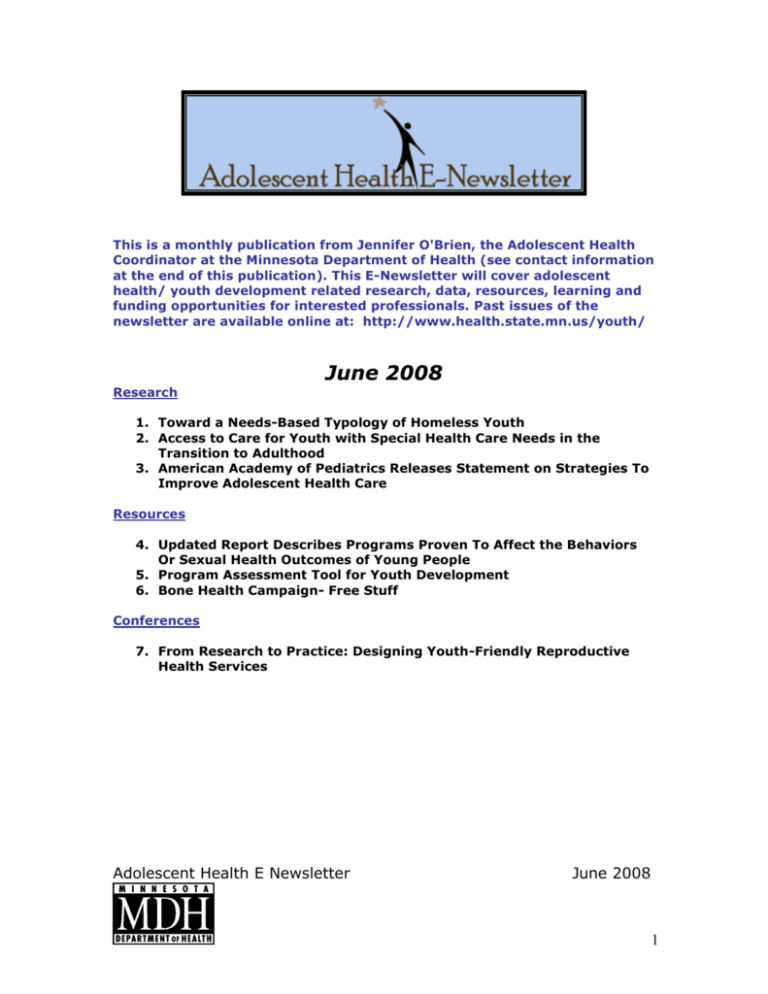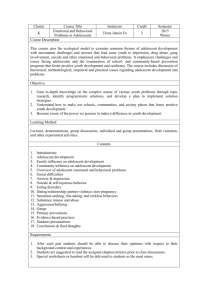
This is a monthly publication from Jennifer O'Brien, the Adolescent Health
Coordinator at the Minnesota Department of Health (see contact information
at the end of this publication). This E-Newsletter will cover adolescent
health/ youth development related research, data, resources, learning and
funding opportunities for interested professionals. Past issues of the
newsletter are available online at: http://www.health.state.mn.us/youth/
June 2008
Research
1. Toward a Needs-Based Typology of Homeless Youth
2. Access to Care for Youth with Special Health Care Needs in the
Transition to Adulthood
3. American Academy of Pediatrics Releases Statement on Strategies To
Improve Adolescent Health Care
Resources
4. Updated Report Describes Programs Proven To Affect the Behaviors
Or Sexual Health Outcomes of Young People
5. Program Assessment Tool for Youth Development
6. Bone Health Campaign- Free Stuff
Conferences
7. From Research to Practice: Designing Youth-Friendly Reproductive
Health Services
Adolescent Health E Newsletter
June 2008
1
Research
1. Toward a Needs-Based Typology of Homeless Youth
Journal of Adolescent Health 42 (2008) 549–554
Carrie E. Coward Bucher, M.A.
Abstract
Purpose: Research on homeless youth consistently suggests a need for a broad
matrix of services to facilitate a successful transition into housed society. This paper
seeks to develop distinct matrices of services for youth according to their
involvement in, or experience with, high-risk factors. Such a typology may increase
the ability of providers to maximize the impact of scarce resources and organize
treatment and reintegration efforts to match the needs of vulnerable youth.
Methods: Seven risk categories were identified in the literature: abusive
experiences, involvement in prostitution, involvement in criminal activities, suicidal
ideation/attempt, living circumstances, alcohol/marijuana use, and the use of drugs
other than alcohol and marijuana. K-means cluster analysis was then used to
separate 422 homeless youth based on their involvement in or experience with these
categories.
Results: Four distinct treatment needs were identified: Group 1—minimal
treatment; Group 2—therapeutic housing with an emphasis on substance abuse;
Group 3—therapeutic housing with an emphasis on behavior management; Group
4—comprehensive treatment.
Conclusions: According to this typology, less than 18% of this sample are
adequately served by the current system of federal intervention, whereas the largest
group is in need of comprehensive services to successfully re-enter housed society.
2. Access to Care for Youth with Special Health Care Needs in the Transition
to Adulthood
Journal of Adolescent Health 43 (2008) 23–29
Debra S. Lotstein, M.D., M.P.H., Moira Inkelas, Ph.D., Ron D. Hays, Ph.D.,
Neal Halfon, M.D., M.P.H., and Robert Brook, M.D., Sc.D.
Abstract
Purpose: To describe access to care and identify factors associated with access for
low-income young adults who aged out of a public program for children with special
health care needs (CSHCN).
Methods: This was a cross-sectional survey of graduates of the Title V CSHCN
program in one California county. Subjects were 77 graduates (55% female) aged
21–24 years with ongoing health care needs. Measures of access to care included
having the following: a regular source of care for the main health condition; all
needed care since turning 21 years of age; any delayed or forgone care in the past
6 months; health insurance; and continual insurance since turning age 21.
Individuals lacking any one access measure were defined as experiencing an adverse
transition event.
Results: Of the subjects, 24% lacked a usual source of health care, 27% had gone
without some needed health care since turning 21, and 39% had delayed needed
care. Although 10% of respondents were uninsured at the time of the survey; 40%
had a gap in insurance coverage since turning age 21. Overall, 65% reported at least
Adolescent Health E Newsletter
June 2008
2
one adverse transition event affecting access to care. Factors associated with
experiencing no adverse transition event were receiving Supplemental Security
Income, having received special education services, and having been born with the
main health condition.
Conclusions: Insurance gaps and delayed care are prevalent among these lowincome young adults despite ongoing health problems. Greater transition support
might improve access by linking them with a usual source of care, identifying
insurance options, and encouraging regular use of care.
3. American Academy of Pediatrics Releases Statement on Strategies To
Improve Adolescent Health Care
Achieving Quality Health Services for Adolescents provides recommendations and
criteria for assessing the quality of adolescent health care and discusses the need for
comprehensive efforts to improve the quality of primary care delivered to
adolescents in the United States. The policy statement, developed by the American
Academy of Pediatrics' Committee on Adolescents, focuses on quality issues that
relate to staying healthy -- preventive care themes. Topics include adolescent health
status and risky behaviors, primary care access and utilization, access to quality care
for adolescents, emerging quality measures for adolescent care, and opportunities
and challenges for primary care. Conclusions and recommendations are included.
The policy statement is available at
[http://aappolicy.aappublications.org/cgi/content/full/pediatrics;121/6/1263 ].
Resources
4. Updated Report Describes Programs Proven To Affect the Behaviors Or
Sexual Health Outcomes of Young People
Science and Success: Sex Education and Other Programs That Work to
Prevent Teen Pregnancy, HIV and Sexually Transmitted Infections identifies
effective programs to help young people reduce their risk for pregnancy and sexually
transmitted infections (STIs), including HIV. The second edition, recently published
by Advocates for Youth, describes 26 programs that met rigorous criteria for
inclusion and strongly affected the behaviors or sexual health outcomes of young
people exposed to the program. Twenty-three of the programs include information
about abstinence and contraception within the context of sexual health education. Of
the three that do not include sexual health education, two are early childhood
interventions, and one is a service-learning program. The programs and their
evaluations are divided into three sections in the report. Section 1 describes
programs designed for and evaluated in school settings, including some that are
linked to reproductive health care. Section 2 describes programs implemented by
community agencies outside the school or clinic environment. Section 3 describes
clinic-based programs. A table summarizing programs’ settings as well as the grade
range, locale, and populations served by each is included. The full report is available
at [http://www.advocatesforyouth.org/programsthatwork/toc.htm ]. An executive
summary is also available at
[http://www.advocatesforyouth.org/publications/ScienceSuccessES.pdf ].
Adolescent Health E Newsletter
June 2008
3
5. Program Assessment Tool for Youth Development
How well do you integrate youth development into your programs? Use this
interactive tool to determine which elements of youth development are strongly
integrated into your program and which are not. Then utilize the NEW resource
pages to help you think about new ways to enhance your program.
Go to the [http://cals-cf.calsnet.arizona.edu/fcs/bpy/assessment.cfm]
For more information or if you have any questions please contact Karen Hoffman
Tepper at karenht@ag.arizona.edu
6. Bone Health Campaign
The bone health campaign ordering form is now live and linked. You can get there
by visiting http://www.girlshealth.gov/bones/games_fun/index.html then click "Free
Stuff" or by visiting the parents site at http://www.girlshealth.gov/parents/bones/
then click "Order materials to help build strong bones".
Conferences
7. From Research to Practice: Designing Youth-Friendly Reproductive Health
Services
August 11, 2008, 1:00 - 5:00 p.m.
Rondo Community Outreach Library,
461 N Dale Street, St Paul, MN
$30 MOAPPP Member/$65 Non-member
This workshop is for health educators, family planning clinic staff and youth-serving
professionals. Laura Davis, Advocates for Youth, Washington, DC, reviews the latest
research on adolescent contraceptive use, addresses best practices for youth-friendly
reproductive health services, explores ways to expand contraceptive and condom
access for underserved teens, and provides information on replicable, evaluated
programs. This program is offered in conjunction with the Minnesota Reproductive
Health Update (go to www.hcet.org for more info). For more information and
registration, go to the program flyer on the MOAPPP website
(http://www.moappp.org/Documents/events/2008/Aug11Flyer.pdf ) or contact Jill
Farris 651-644-1447 x18 or jill@moappp.org. Registration deadline is August 7.
****************************************************************
For more information on Adolescent Health at MDH, please contact
Jennifer O’Brien, MPH
Minnesota Department of Health
P.O. Box 64882
St. Paul, MN 55164-0882
Jennifer.obrien@health.state.mn.us
651-201-3627
Past issues of the newsletter are available online at:
http://www.health.state.mn.us/youth/
Adolescent Health E Newsletter
June 2008
4






